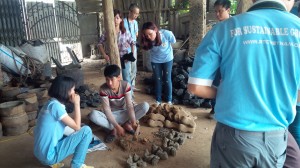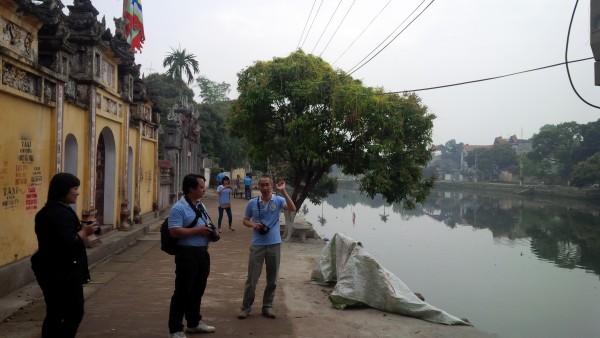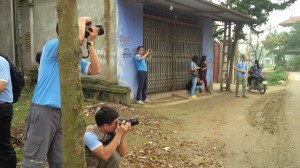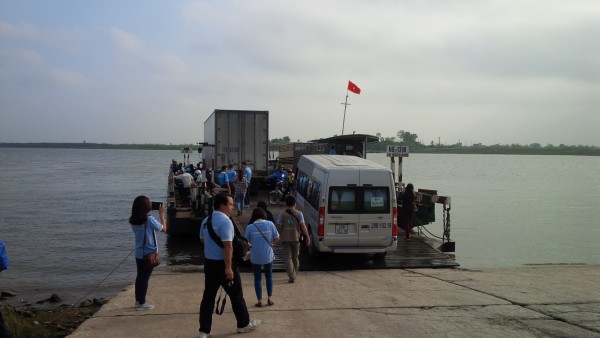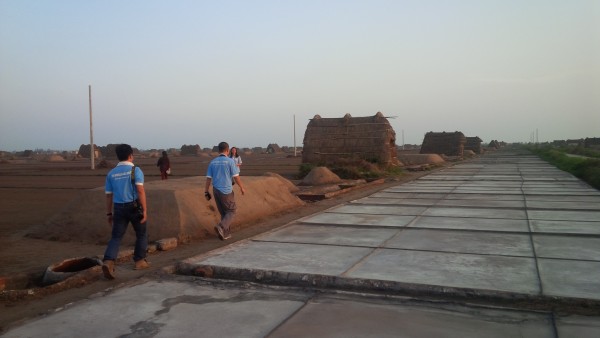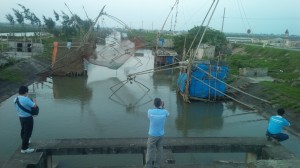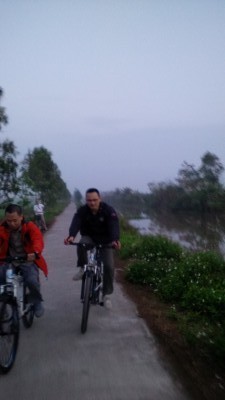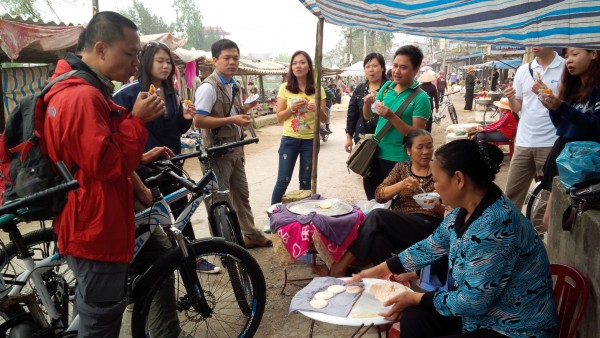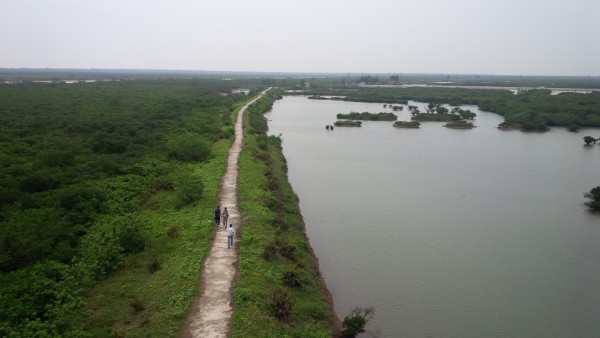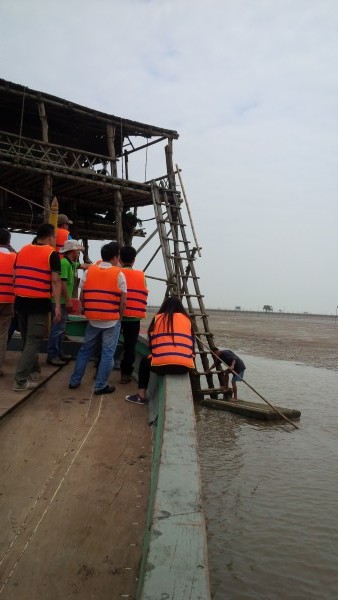On March 28-29th, 2015, with logistics support from Ecosea Travel, a new official member of RTC, 13 members of the Responsible club of Vietnam have organised a 2-day trip to Thai Binh and Nam Dinh to inspect new cultural immersion experience in two relatively new and promising destinations for developing community based tourism, Nam Dinh and Thai Binh.
Located in the Red River Delta – Thai Binh and Nam Dinh are the neighbours with same long-standing tradition culture. Nature has bestowed Thai Binh and Nam Dinh with a diverse range of natural landscapes and many advantages to develop tourism, especially responsible-oriented tourism namely ecotourism and community based tourism.
Nom ancient village – Dai Dong commune, Van Lam district, Hung Yen
On the way to the Thai Binh – Nam Dinh, inspection team visited the ancient village called Nom in Dai Dong commune, Van Lam district, Hung Yen province. This destination can build up a unique village tourism product with some highlights of banyan trees, old communal wells, village communal house, temples, markets, the village entrance and archaic houses. The village also has an ancient stone bridge over 300 years old of nine dragon-engraved spans, built under the Le Dynasty. Nom Temple, a very sacred and imposing one – on the area of 15 hectares has 100 Buddha earthenware statues. Traditional bronze casting is also well-known for sophisticated products. Under Nguyen Dynasty, Nom village was assigned to mint coinage to the monarch.
Thai Binh Garden
It took a woman with a motorbike, then another women in bicycle to lead us into the discrete area of Thai Binh Garden. Otherwise, no signage are found within immensely green rice fields and shady ageing trees. Mrs.Hang, owner of this eco-friendly, rustic bungalows complex have greeted us with a huge smile and a warmly welcome ceremony as if we’re long lost relatives. Being a descendant of her parents’ land, and a child of a rich cultured province, Mrs.Hang has built this accommodation with a pure philosophy in mind “I just want to introduce my hometown to everybody all over the world. I want them to come to Vietnam to experience the rural life, to meet with hospitable Vietnamese ordinary people so that they come back to their country with a heart warmed and lighted”.
Thai Binh Garden comprises of 4 relatively large room roofed with palm tree leaves and bamboo made furnitures. Windows are huge and offer a wide view of the rice fields in front, or the green vegetable garden planted and taken care of everyday. Meals are served with fresh ingredients within the garden whether it’s veggies or fish, or chicken, Thai Binh Garden has them partially self supplied. Plus, the staff team is the local people living in this small rural village. The surroundings of Thai Binh Garden are pretty much typical rural life which is perfect for biking and walking. Cultural immersion activities such as farming, fishing are often highly rated by the past customers here.
Thien Nhan Village – Bach Long salt field, Nam Dinh
Giao Thuy district, Nam Dinh can be accessed from Thai Binh via a short ferry of roughly 15 minutes. Leaving Thai Binh, the inspection team went to the Nam Dinh province, visited Thien Nhan village – the hometown of the former General Secretary Truong Chinh and the story of how many local people from this town have acquired a successful career following the philosophies and spirit of Truong Chinh. Just right next the intellectual town, there came Bach Long salt field. The salt field still retains the rustic beauty with the idyllic thatched roofing. Salt are often filtered in the afternoon (around 3-4PM) after being dried under the sun the whole day. Shrimp and fish ponds are next and decorated by net-liftings which make it an absolute peaceful scenery and truly rewarding.
Homestay and traditional folk arts performed by Giao Xuan community
The day sums up with a homestay overnight at two local homes in Giao Thuy. The hosts have endured with us and warmly welcomed us into their houses. Dinner was organised by Ecosea Travel at their restaurant and followed up by a 30 minute show of many traditional folk art performed by the locals such as love duets (Quan họ), Chau van and so on. For a big group, dinner will be served at Ecosea restaurant but RTC has advised them to organised dinner at a homestay in order to allow the local interaction between guests and the host, an essential part of a homestay experience.
Xuan Thuy National Park – Ba Lat estuary
The second day was highlighted by Xuan Thuy National Park – the first mangrove forest in Vietnam to be internationally recognized by the Ramsar Convention, the 50th mangrove forests of the world. This is a great place to design a diverse range of activities such as walking, trekking, cycling, or sailing (at high tide) through the mangroves and observing the birds migrating to this National Park. Another interesting route is to sail from Xuan Thuy National Park to the Ba Lat estuary – where the Red River mingles with the sea. An opportunity not to be missed is to visit wooden huts erected well above the sea surface in Ba Lat estuary and have a meal with fishermen on their huts.
Seafood market – Making fish sauce, shrimp paste
Some other typical activities in a coastal area are to explore the morning seafood market – where fishermen bring fresh seafood ashore after a night of fishing offshore, to visit and learn the process of making fish sauce and shrimp paste at a local traditional household, or to discover the rural markets with delicious foods and coast-specific commodities.
With a new highway connecting Hanoi and Nam Dinh and the ideal location of Thai Binh as a mid break between Hanoi and Halong, Nam Dinh and Thai Binh has what it takes to develop tourism here with community based oriented tourism. Narrowing the capacity down to small groups is a critical factor for these two emerging destinations to develop sustainably.
Pham Ha – Lan Chi










